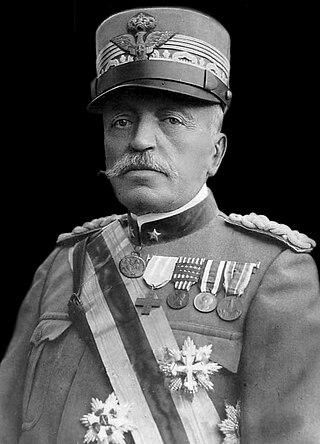
Marshal of Italy Luigi Cadorna, was an Italian general, Marshal of Italy and Count, most famous for being the Chief of Staff of the Italian Army from 1914 until 1917 during World War I. During this period he acquired a reputation for rigid discipline and the harsh treatment of his troops. Cadorna achieved successes at the battles of Asiago and Gorizia but, following a major defeat at the Battle of Caporetto in late 1917, he was relieved as Chief of Staff.

Armando Diaz, 1st Duke della Vittoria, was an Italian general and a Marshal of Italy. He is mostly known for his role as Chief of Staff of the Regio Esercito during World War I from November 1917. He managed to stop the Austro-Hungarian advance along the Piave River in the First Battle of Monte Grappa. In June 1918, he led the Italian forces to a major victory at the Second Battle of the Piave River. A few months later, he achieved a decisive victory in the Battle of Vittorio Veneto, which ended the war on the Italian Front. He is celebrated as one of the greatest generals of the war.
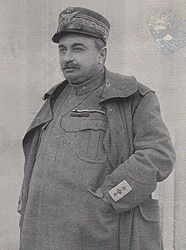
Luigi Capello was an Italian general, distinguished in both the Italo-Turkish War (1911–12) and World War I.
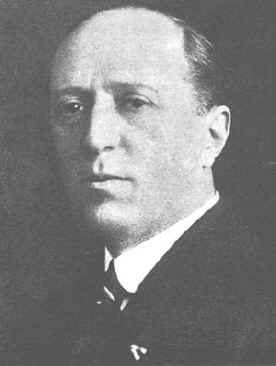
Sebastiano Visconti Prasca was an Italian general. A veteran of the Italo-Turkish War of 1911–1912 and World War I, he led the initial offensive of the Greco-Italian War in 1940 during World War II, but was relieved of his command after two weeks for incompetence and relieved by General Ubaldo Soddu.
The Gold Medal of Military Valor is an Italian medal established on 21 May 1793 by King Victor Amadeus III of Sardinia for deeds of outstanding gallantry in war by junior officers and soldiers.

Vincenzo Garioni was an Italian general who saw combat in the Boxer Rebellion, Italo-Turkish War, and World War I. He was the governor of Tripolitania from 1913 to 1914 and later served as the governor of both Tripolitania and Cyrenaica from 1918 to 1919.

Giorgio Cigilana (1857-1919) was an Italian general. He had been the governor of Tripolitania for a short time in 1914.

The 11th Bersaglieri Regiment is an active unit of the Italian Army based in Orcenico Superiore in the Friuli Venezia Giulia region. The regiment is part of the army's infantry corps' Bersaglieri speciality and operationally assigned to the 132nd Armored Brigade "Ariete".

The 1st Bersaglieri Regiment is an active unit of the Italian Army based in Cosenza in the Calabria region. The regiment is part of the Italian infantry corps' Bersaglieri speciality and operationally assigned to the Bersaglieri Brigade "Garibaldi". The Regiment is among the most experienced units of the Italian Army in missions abroad, and is the regiment with the highest number of decorations for military Valor of the army.

The Battle of Ain Zara was fought in December 1911 during the Italo-Turkish War between the Kingdom of Italy and Ottoman Empire forces for the control of the oasis of Ain Zara, near Tripoli in modern Libya, where the Ottomans had established a fortified base.

Gustavo Fara was an Italian general and politician.
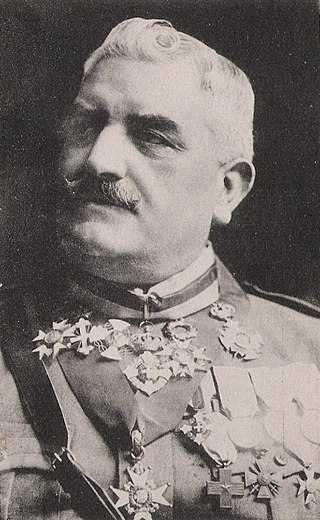
Giuseppe Pennella (1864-1925) was an Italian Lieutenant General who was a highly decorated officer of the Royal Italian Army. During the First World War he held very high positions, commanding in succession: the "Grenadiers of Sardinia" Brigade, 35th Division, XI Army Corps, 2nd Army, 8th Army and the XII Army Corps. At the head of the 35th Division he operated in the Macedonian front, but was exonerated from command at the request of the French general Sarrail who was commander of the Armée d'Orient, as both had a strong disagreement over command.
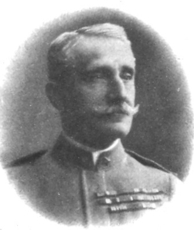
Vittorio Camerana was an Italian general who commanded the III Army Corps of World War I. At the end of the war, he was promoted to General of the Army Corps and decorated with the Grand Officer Cross of the Military Order of Savoy.

Luigi Nava (1851-1928) was an Italian General of the Army who participated in the First Italo-Ethiopian War and World War I. He participated in the Italian colonial campaign in the Horn of Africa which lead to his participation at the Battle of Adwa, where he was wounded and taken prisoner by the Abyssinians. Having become Lieutenant General, at the action of the general mobilization of 1915 he was appointed commander of the 4th Army but was dismissed from the command four months after Italy entered the war.
Amedeo De Cia was an Italian general during World War II.
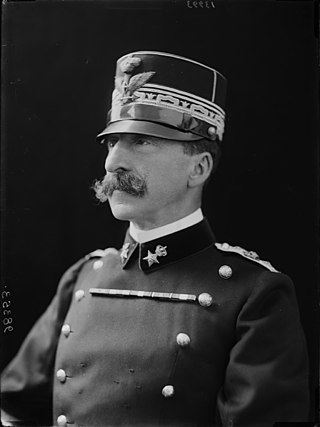
Ugo Pio Enrico Natale Brusati, was an Italian General who participated in the First Italo-Ethiopian War and World War I. He gained notability for his service at the Battle of Adwa as well as being the First Adjudant General of Vittorio Emanuele III on 2 June 1902 until 23 October 1917, when Luigi Cadorna forced him out of the office.

Leopoldo Cesare Prato was an Italian major of the First Italo-Ethiopian War. He commanded the 6th African Infantry Battalion during the Battle of Adwa before being killed in the battle. He was also a posthumous recipient of the Gold Medal of Military Valor for his service in the battle.

Giuseppe Antonio Baudoin was an Italian major of the Third Italian War of Independence and the First Italo-Ethiopian War. He commanded the 9th Africa Infantry Battalion during the Battle of Adwa before being killed in the battle. He was a posthumous recipient of the Gold Medal of Military Valour for his service in the battle.

Gaetano Tavoni was an Italian Alpini officer, commander of the 9th Alpini Regiment. He was mortally wounded during the Greco-Italian War and posthumously awarded the Gold Medal of Military Valor.

The 67th Infantry Regiment "Legnano" is an inactive unit of the Italian Army last based in Solbiate Olona. Formed in 1862 and originally named for the city of Palermo the regiment is part of the Italian Army's infantry arm. Since 1939 the regiment is named for the medieval Battle of Legnano.


















